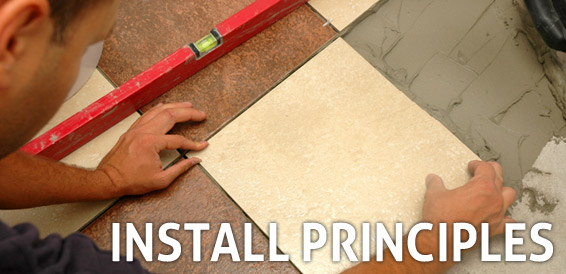Installation Principles
This system consists of four integral components. The failure of any component means the failure of the entire installation.
1. Substrate
What is the condition of the substrate that you’re going to set the tile on? Is it clean and ready for tile? Is it properly cured? How will cracks be prepared? Is it level? Are there any humps, bumps or dips? How will you address expansion joints? The number one job complaint received by the Tile Council of America (TCA) revolves around inadequate preparation of the substrate and no expansion joints. Use the TCA Handbook for information regarding placement of movement joint’s.
2. Tile, trim and installation materials
Tile. “It’s all good”. Overall, tile is much better than it was 20 years ago. There are a few sub-standard products, but by and large tile is a bargain over the life of the product when compared to other flooring surfaces.
Trim. Make sure that the trim shapes perform the intended function and that they coordinate in color, shade, thickness and overall dimensions with the tile.
Installation Materials. If you skimp somewhere, don’t skimp here. As a matter of fact, many thin-set manufacturers offer lifetime warrantees on their premium polymer or latex modified setting systems (thin-set and grout). Pennies a foot for a lifetime warrantee? Sounds like a bargain insurance plan to me!
3. Installation, caulking and clean up Installation.
Sure tile is a great DIY product, however, you cannot beat the finished look of an installation when completed by a true professional. A professional tile setter will make sure that the substrate is ready to accept the tile, select the proper installation materials, layout the installation in a manner that will enhance the overall appearance and give you an installation that will last at least 40 years.
Caulking and clean up. The difference between a good installation and a poor installation is in the details. The caulk joints, the grout clean up and the overall condition of the installation is critical to produce a beautiful job.
4. Cleaning and sealing
Most slip-fall accidents don’t come from the wrong product being installed, but from inadequately maintained surfaces. As a rule, tile should be cleaned with a neutral cleaner. Vinegar, the cleaner we all used to recommend, won’t harm most tiles, but can destroy the grout – don’t use it. Change your mop water often. Hint: throw a quarter in the bottom of your mop bucket. When you can’t see it-change the water.
Sealing. Glazed ceramic tile is never to be sealed. All stones must be sealed. Many unglazed porcelain tiles must be sealed. Sealing the grout can bring the absorption of a latex modified grout down to less than 1% absorption. Sealing makes it easier for you to clean your grout, but your grout still requires cleaning (where’s that self-cleaning grout?). My personal recommendation: pick out a dirty colored grout and you’ll always be happy.



